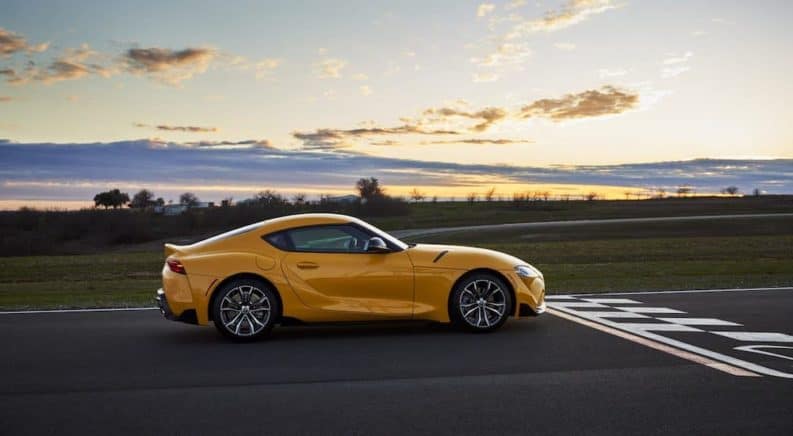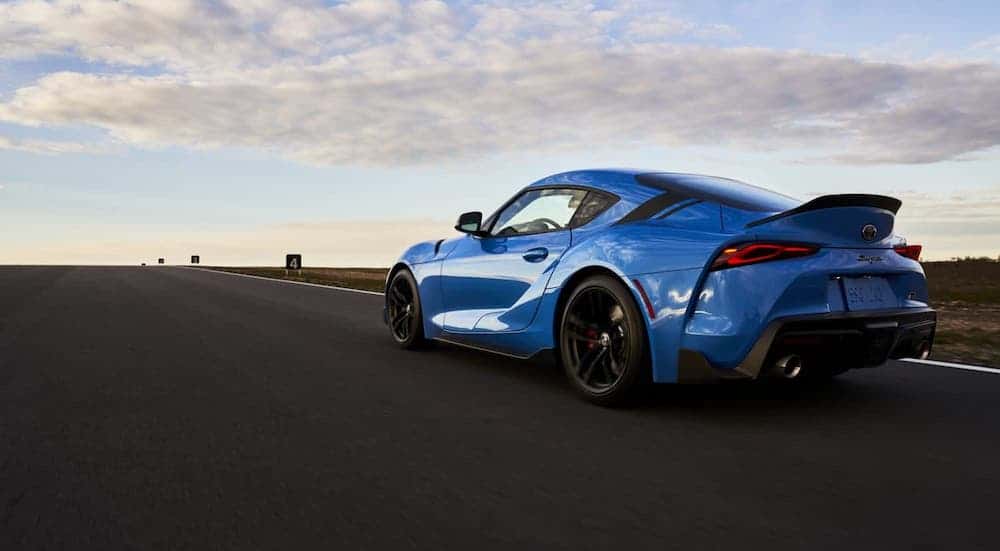The new Toyota GR Supra has been mired in controversy since its introduction last year. Everything from its BMW engine to its admittedly questionable styling choices has come under attack from automobile enthusiasts. And in early February, Toyota announced that for the 2021 model year, it would be making some major changes to the Supra.
On paper, these changes not only make the Supra more competitive, but they will also make it more available to a wider range of buyers. However, for many detractors, these changes have only given them more ammunition for their attacks on the Supra. So what should be expected from the 2021 Supra, and are the criticisms leveled at the car accurate?
Toyota’s Performance Past
Today, Toyota’s products are commonly considered to be boring but highly reliable vehicles aimed at the mass market rather than at enthusiasts. Indeed, the average driver may well be surprised to learn that Toyota has ever manufactured performance cars.
But although Toyota did a number of exciting vehicles in the past, they were all phased out by the early 2000s. The original Supra departed the American market back in 1998, with the lightweight mid-engine MR2 and sporty Celica following in 2005. The reasons given for the discontinuations at the time were mostly about declining interest in sports cars and low profit margins on those models. Performance was not the issue, and even today, many look back fondly on the sporty Toyotas of the 1990s.
However, Toyota never fully abandoned its racing past and has continued to provide cars for motorsports from NASCAR to Formula One. Toyota began its return to the performance of consumer cars less than a decade after it discontinued its older models when it collaborated with Subaru to design and build the Toyota 86. In the American market, this design (which was named after Toyota’s legendary AE86 Corolla) was sold from 2013 as both the Scion FR-S and the Subaru BRZ. However, with the demise of the Scion marque in 2016, it was rebranded to its original Toyota 86 moniker.
But although this small sports car received accolades for its excellent handling, it was also dogged by a reputation for being underpowered and had a sparse interior. To remedy these complaints, Toyota decided to build a new sports car and again turned to its past for inspiration.
The Supra Reborn
However, Toyota understood that demand for sports cars had not improved significantly over the preceding two decades and needed another manufacturer to share costs in order to make the new Supra affordable. And because the old Supra had been powered by an inline six-cylinder engine, Toyota also wanted a partner that could provide a similar engine for the new Supra (Toyota itself only had V6 engines in its line up). Naturally, this led Toyota to a certain Bavarian manufacturer renowned for both its performance cars and its inline six-cylinder engines.
The result of the Toyota-BMW partnership was an excellent blend of performance and cost. Weighing slightly under 3,400 pounds and with an engine producing 335 hp and 365 lb-ft of torque, the new Supra was both lighter and more powerful than the previous generation. And with a zero-to-sixty time of well under 4 seconds, a top speed of over 150 mph, and the ability to pull over 1 G on the skidpad, the new Supra demonstrated that it could compete with cars that cost far more than its $50,000 price tag.
But despite these numbers, the complaints poured in. People were disappointed with its aggressive modern styling and numerous fake air vents. There were complaints that it only had 15 more horsepower than the old Supra (although it had 50 more lb-ft of torque, and it is quite clear that the engine was underrated). Some were annoyed that it only had an 8-speed automatic transmission instead of a dual-clutch or a manual. But the single most common complaint was that the new Supra was not a Toyota––the engine says BMW on it, and it was built in Austria.
The 2021 Update
In early February, Toyota announced that there would be two major changes for the 2021 Supra. First, it would receive a more powerful engine, and the chassis would be updated for greater stability and rigidity. Second, there would now be a lighter and simpler version equipped with a four-cylinder engine.
The new engine has attracted most of the attention, both good and bad. Now producing 382 hp and 365 lb-ft of torque, Toyota claims that the zero-to-sixty time of the 2021 Supra will fall from 4.1 seconds to 3.9 seconds. And given that independent testing has already produced times lower than that with the 2020 Supra, it is likely that the 2021 Supra will do even better in reality. However, Toyota’s retuning of the chassis may prove just as valuable as the new engine. Not only is it receiving physical reinforcement in key areas, but the various electronics from the power steering to the active differential are also being reprogrammed to make the 2021 Supra more agile.
But while these changes will make the 2021 Supra even more competitive, many are asking why Toyota released the 2020 Supra in the form that it did when such a significantly improved version was in the works? And just as importantly, will such year-to-year changes be common with the Supra? If Toyota cannot convincingly answer these questions, then these improvements may end up hurting rather than improving Supra sales, as potential buyers hold off making a purchase out of the fear that next year’s version might be even better.
The Smaller Supra
With the debate revolving around the changes to the six-cylinder Supra, the introduction of the four-cylinder Supra has mostly flown under the radar. The smaller Supra was actually already released in Japan and Europe for 2020, and (unlike its larger brother), it will not have any changes to its engine for 2021.
However, the smaller Supra is not simply a cheaper Supra. It will be over 200 pounds lighter than the six-cylinder version, and Toyota has paid close attention to ensure that the weight reduction has not affected the 50:50 balance of the car. When combined with the same wide tires of the heavier Supra, this should give the four-cylinder version excellent turning performance. Engine output will be 255 hp and 295 lb-ft of torque, with Toyota claiming a zero-to-sixty time of 5 seconds. But based on what we’ve seen, it seems probable that real world performance will be better.
Still, the smaller Supra will lack some major features found on the six-cylinder version. The most important missing equipment is the active differential and adaptive suspension (hopefully, it will have a mechanical differential, but that is currently unclear). It will also have two-piston instead of four-piston brake calipers. On the inside, some of the weight reduction comes from manual instead of power seats and a 4-speaker sound system (though this latter can be remedied with the 12-speaker setup in the technology package).
All in all, the new four-cylinder Supra should slot nicely between the six-cylinder Supra and the Toyota 86. It should also provide a solid competitor in a segment of the performance car market that has not seen much change in many years, as its price and performance should put it in line with cars such as the Honda Civic Type R, the Subaru STI, and the aging Nissan 370Z.
Although both versions of the 2021 will face an uphill fight to gain popularity, their performance numbers and price tags mean that they should be able to overcome initial opposition. And barring any more unexpected surprises, the 2021 Supra should pave Toyota’s way to fully returning to the world of performance cars.






